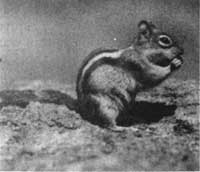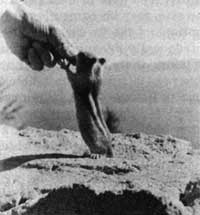A squirrel gathering bedding works vigorously with forepaws and teeth to loosen grass which is taken between the jaws. The squirrel then stands up and trims this load into a neat bundle. More grass may be added and the trimming process repeated. Thus to arrange the load between the jaws a squirrel makes rapid and complicated movements with the forepaws. As a result he can run with his grass sheaf without stepping on loose ends and as the bundle does not project laterally much further than the ears the squirrel can enter a tunnel entrance on the run without embarrassment. A squirrel running with bedding has been seen to stop, stand up and retrim his load when a loose end of dried grass became detached and started to drag. On one occasion a squirrel running down the inner wall of the Sinnott Memorial ramp, stopped at the lower turn where two visitors offered him peanuts. To accept these the squirrel was obliged to put down his sheaf of grass and by running down the ramp the writer was able to prevent the squirrel from retrieving the grass before he ran away. This grass sheaf was in the form of an 8 which the squirrel had been holding in the center so a loop projected on each side. The grass in this bundle held together and could be lifted by the center or either loop without becoming disentangled.
Like most rodents the golden-mantled ground squirrel grooms himself around the head, neck, and belly with his fore paws. Hinder parts except the tail, are worked over with the teeth. The tail is combed by a sort of shucking motion with the fore paws and combed with the teeth as well. Grooming is particularly important in small mammals since a smooth coat conserves heat which radiates rapidly from the relatively large surface of a small creature. Squirrels dust themselves by a moderate rolling in dust piles often raised by a few rapid paw strokes for the purpose. They frequently save time by diving into dust like a base-runner making a head-first second. Frequently after the dive they lie spread-eagled in the dust for a brief period and this same position, with all limbs extended, may be used in resting. A well nourished little squirrel thus stretched out, after an interval of peanut gathering, has all the air of smugness carried by a lucky investor after a hard hour of coupon clipping.
 “. . . edible objects are always lifted first by the jaws and then transferred to the forepaws . . .” |
Squirrels forage busily and nose over the ground for food. They frequently forage by standing on the hind limbs while they reach out and pull vegetation to the mouth with the fore paws. In this manner they nibble young leaves and flower buds of Newberry’s knotweed and bleeding-heart and the seeds of wild grasses, the heads of which they obtain by arm over arm reeling in of the stem. It is interesting that in spite of this use of the fore limbs in a special circumstance, that edible objects like peanuts are always lifted first by the jaws and then transferred to the fore paws for manipulation during husking or fragmentation prior to storage in the cheek pouches. Occasionally a squirrel with its mouth full of food will clutch an object on the ground and pull it toward the body but will then merely hold it with its paw until the mouth can be used as the grasping organ.
The golden-mantled ground squirrel has a vocabulary of at least four different sounds. There is a high- pitched “peesk” which is quite bird-like in tone, sometimes followed by a trill which is rather more musical than the similar trill of the western chipping sparrow. Both single and multiple noses seem prompted by excitement or alarm. These sounds are made while sitting, sometimes with one foot raised. The mouth is widely opened for the first sound and the body vibrates obviously with the trill. On August 6, 1938, the writer stopped to investigate a singing squirrel which had gathered an audience of a number of campers. One of them estimated that the squirrel, presumably a female since it was occasionally followed by young, had already sung for an hour and “sang almost every day!” There is a throaty little growl which is uttered as a warning to interlopers and during pursuit of them or while in the throes of combat. This sound is commonly employed when squirrels are competing for peanuts. Rather rarely a squirrel running from a pursuer, utters a series of high squealing notes when pursuit is close. In general these animals are rather silent and are usually credited with the single note first mentioned (Bailey, 193, p. 140).
 “It takes young squirrels a little while to accustom themselves to eating from visitors’ hands.” |
It takes young squirrels a little while to accustom themselves to eating from visitor’s hands. No critical test of this has been made, but by using experience at Government Headquarters as a criterion, it can be said that some young squirrels accept food the second or third day it is offered. Conditioning appears to be continuous over a long period for the biggest end presumably oldest individuals usually show the least hesitation. Even when young squirrels are taking food readily from the hand the bristling of the hairs on the tail show that the situation is producing considerable emotional disturbance. Emotionality in animals is difficult to estimate and this pilomotor response might be used in behavior experiments.

